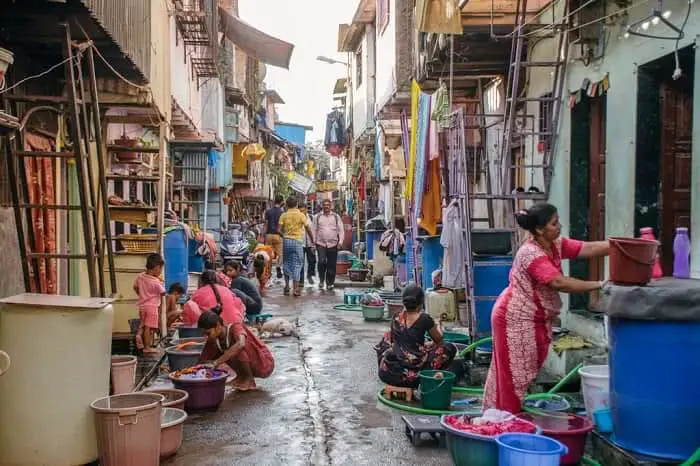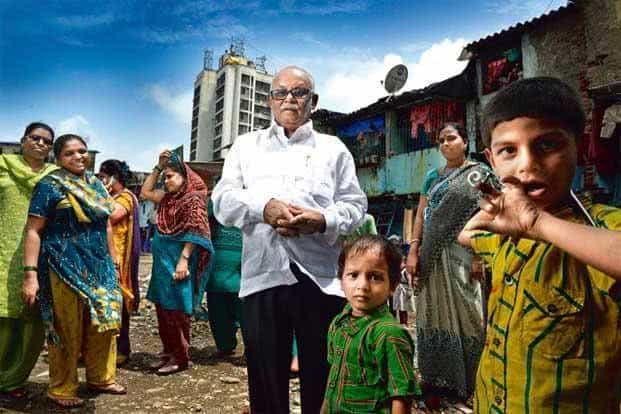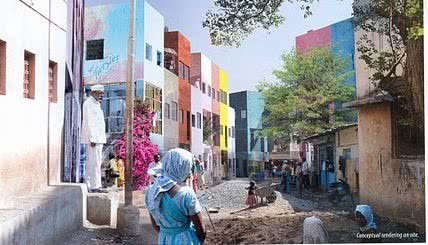
The causal dimension of critical spatial theory framework:
As a financial capital of India, Mumbai is an attractive destination for migrants who come to this city of opportunity, to improve their economic status and to escape rural poverty (Hohmann, 2010). This makes Mumbai create both formal and informal jobs bringing more population to service those jobs which put pressure on housing demands (Patel, 2010) but the geographical layout of small island city could not adequately house all of these workers and their enterprises (Peterson and Macdonough, 2011). Not all employers can afford to provide housing for their new employees, and they are not legally bound to do so. On the other hand, the state does provide an only tiny fraction of the housing demand because they cannot afford to provide the minimum standards set for a decent house and provide the corresponding infrastructure such as water supply, sanitation or garbage collection. Therefore people who are given jobs have to house themselves by illegally occupying any vacant land they can find (Patel, 2010). Also, there is no control over the freely permitted growth of jobs in the city. In fact, they are located in the town to take advantage of a cheap labor pool which makes it cheaper as the workers compete among themselves by accepting lower wages and miserable leaving conditions (Patel, 2010). These poor quality human settlements encroach on public lands or wherever else space can be found with various government agencies not taking any action against them. They locate themselves on road margins and vulnerable locations like river banks, drains, swamps, garbage dumping yards, along railway lines etc (Ministry of Housing and Urban Poverty Alleviation, 2011).
Related: Planning and Informality in India by Avnika Nagar

Lack of proper planning for basic infrastructure and housing facilities by the public agencies, resulting in deterioration of the physical environment which affect the quality of life of urban poor. The lack of formal space for urban poor in the city master plan has also forced them to settle for informal solutions causing the development of slums in the city (Ministry of Housing and Urban Poverty Alleviation, 2011). Thus Slums and squatter settlements are the clear indications of the failure of government and society to provide adequate habitat for human development. There are also some legal issues involved with such squatter settlements. According to Section 27 of the Limitation Act, 1963 if the occupant of the government land occupies the land for more than 30 years, then he or she can claim title to the property. Interestingly many residents of Mumbai slums have been there for more than 30 years. (Patel, 2010). Also, for a slum dweller, it is just not a place to stay, there is an industry attached to it where the resident has the control over land and the resource. As a result, all these factors slums have become a permanent eyesore and extremely difficult to eradicate. However, self-motivated slum dwellers’ communities are helping themselves to improve their quality of life (Burra, 2005).
A communicative dimension of critical spatial theory framework:

The community is mobilized with the alliance of the urban poor and takes a leading role in driving city-wide initiatives for safe, secure and livable housing and infrastructure (SPARC, 2004). Since mid-1980 group of NGOs such as Society for the Promotion of Area Resource Centres (SPARC) and people’s organization like The National Slum Dweller’s Federation (NSDF) and Mahila Milan have been active in the slum rehabilitation programmes. It has demonstrated the capacity of urban poor to design, build and manage projects to improve their housing condition and provision of essential services. Hundreds and thousands of slum dwellers are members of NSDF, and the mere scale of these organizations have made government authorities to take them seriously and negotiate collectively for their land entitlement. Thus, various federations like Railway Slum Dweller’s Federation (RSDF), the Airport Authority Slum Dwellers Federations (AASDF), Pavement Dweller’s Federation (PDF) and the Dharavi Development Committee (DDC) in Mumbai negotiate with their respective authorities (Burra, 2005).
Related: Important Concepts in Urban Renewal- JNNURM
NSDF helps in exchanging the ideas and information of different communities within the city and across other cities of India and breaks the isolation by allowing them to be part of the larger interdependent process. These exchanges serve as learning tools, which share solutions tried in other communities. The information regarding financial, organization, managerial, construction and technical knowledge is continuously updated with new leaders being introduced (SPARC, 2004). Mahila Milan is a decentralized network of women and pavement dwellers based on daily saving and credit facilities and focuses on better housing and infrastructure. SPARC, on the other hand, is a legal entity which acts as a mediator between government authorities and these slum dweller’s organizations. SPARC goes beyond this role of mediation and provides exposure to these community organizations in gaining enough experience to deal with the government authorities directly (Burra, 2005). As part of strategies of this alliance, housing exhibitions are held, where urban poor get together and present house models prepared by them. They are designed to fit their economic standards and specific requirements. Other communities and the state officials are invited to examine the spatial aspects and vote for the model they like the best (SPARC, 2004).
Such community mobilization went beyond the national boundaries when a global campaign was launched in the year 2000. There were series of meetings and events held with central and state ministers, diplomats, UN officials and members of Slum/Shack Dwellers International (SDI) in Mumbai, where the Chief Minister of Maharashtra state talked about the impending legislation to provide secure tenure for the urban poor. The role of the state is vital as it either produces, controls or regulates the basic needs of urban poor such as land, water, sanitation, electricity and housing finance. Such engagement with the state is necessary to make them aware of their responsibilities towards the urban poor and not leave them to the mercy of markets (SPARC, 2004).
Action dimension of critical spatial theory framework:

The efforts of these community organizations and pressure groups made the government think seriously on matters related to slum up gradation. Initially, since independence, there have been some efforts of slum up gradation being done by the government. However, in 1985, the government offered to secure a long-term legal plot to slum households on the basis that they would invest in their housing. Unfortunately, the policy could only attract 10-12% of the slum households who were capable of upgrading their homes and disregarded those who did not have homes at all (Mundu and Bhagat, 2008). Later, in 1995 Slum Rehabilitation Act was passed by Govt. of Maharashtra to protect the rights of slum dwellers on municipal land by producing any document showing that they are living in the city before January 1995 (Burra, 2005).
In 1995, one of the key election promises by the government had been to provide 800,000 free houses to 4 million slum dwellers in Mumbai. A study group which was appointed by the government showed that slum dwellers lived on land belonging to various central and state agencies or public bodies and recommended to make provision for urban poor without disturbing the open spaces and other amenities as provided in the development plan. A slum rehabilitation authority (SRA) was set up for the coordination between multiple executing agencies such as private sector developers, public bodies, NGOs and cooperative housing societies of slum dwellers. It became a planning authority for slum areas, and the municipal and state legislation was amended, giving them discretional powers to make changes to the development plan of the city and to provide building permissions. The authority was headed by a minister and had a senior bureaucrat as the chief executive (Burra, 2005).
The most favored instrument for slum rehabilitation is the grant of extra FSI to cross-subsidise the housing of the poor from the market. This instrument applies to public infrastructure projects like Maharashtra Urban Transport Projects (MUTP) and Mumbai Urban Infrastructure Projects (MUIP). The developer could afford to provide free house and Rs 20,000/- family contribution by selling extra apartments in open market. Additional benefits include a reduction in municipal tax which is pegged at 20 percent of existing rates and then increasing them gradually to reduce the burden on slum families. Other than housing, slum rehabilitation also include extra floor space to commercial areas such as shops and restaurants. Aligning the interests of slum dwellers is one of the major problems in implementing Slum Rehabilitation Schemes. The alliance of SPARC, NSDF and Mahila Milan take up their slum up gradation projects at their costs and has rehabilitated a large number of slum dwellers due to infrastructure projects. Community-Led Infrastructure Finance Facility (CLIFF) was set up to help these community organizations and carry out and scale up community-driven infrastructure and housing projects in conjunction with municipal authorities and the private sector (including banks and landowners). The funding for CLIFF is channeled through Cities Alliance and the UK charity Homeless International (which helped develop the concept of CLIFF with the Alliance). Financing from international organisation such as UK and the Swedish bilateral aid programmes (the Department for International Development and the Swedish International Development Cooperation Agency-Sida), is unusual in that it provides funding for projects that are developed locally, on a larger scale than is usually available to NGOs and people’s organisations (Burra, 2005).
Conclusion:
In conclusion, from the above discussion, all three aspects of critical spatial theory framework analysis, i.e., causal, communicative and action opens up to view each aspect of any particular issue and integration of all three aspects give an understanding of the specific issue, in this case, it is the issue of Mumbai slums. It follows its sequence, and each component is equally important in the process. However, the third aspect of critical spatial theory framework analysis is not very effective in its implementation, and the basic cause, i.e., rural migration has not been addressed effectively leading to lack of action on ground and lethargy. The policy framework and the legal status of these slums require an integrated approach. Policies are superficial, and the needs of the slum communities have not been addressed sincerely by the government. The community organization although strong, lack proper education and skills to negotiate with the government and put forward their issues to local authorities. More comprehensive actions which would fulfill the basic needs of water, sanitation, garbage disposal, electricity and most importantly the up gradation of housing are required on the ground and should be backed up by the international funding sources such as World Bank. NGOs such as SPARC should encourage and educate slum communities to access these international organizations and take advantage of these resources.
You May Also Like: Pragmatic Approach to Slum Rehabilitation in Mumbai City (Part 1 of 4)
References:
Burra, S. (2005) Towards Pro-Poor Framework for Slum Upgrading in Mumbai, India. Environment and Urbanisation [online]. 17(1) pp. 67-88
Hohmann, J. (2010) Visions of Social Transformation and the invocation of human rights in Mumbai: The struggle for the right to housing. Yale Human Rights And Development Journal [online]. 13(1) pp. 135-184. [Accessed 19 November 2015].
Jagdale, R. (2014) An Overview of Slum Rehabilitation Schemes in Mumbai, India. Msc, University of Texas. [Accessed 10 November 2015].
Landon, M (2006) Environment, Health and Sustainable Development [online]. Maidenhead: Open University Press [Accessed 21 November 2015].
Mundu, G. and Bhagat R. (2008) Slum Conditions in Mumbai Concerning Access Of Civic Amenties [online]. ENVIS Centre 5(1). [Accessed 17 November 2015
Operational Research Group (1989) Accessibility to Basic Services in Slums of Five Urban Centres. [online]. Operational Research Group: Baroda. [Accessed 20 November 2015].
Peterson, M. and McDonogh, G. eds. (2011), City in the Twenty-First Century: Global Downtowns [online]. Philadelphia, PA, USA: University of Pennsylvania Press [Accessed 18 November 2015]
Registrar General of India (2001) Analytical Report on Housing Amenities, Series I, Census of India [online]. Registrar General of India: Delhi. [Accessed 20 November 2015].
Retnaraj, D. (2001) Fast Growing Cities, Spurt in Land Prices and Urban Slums: The Kerala Experience. IASSI Quarterly [online] 20(2) pp.123-133. [Accessed 18 November 2015].
SPARC (2004), Cities Alliance Project on Pro-Poor Slum Upgrading Framework for Mumbai, India [online]. Mumbai: SPARC. [Accessed 30 November 2015].